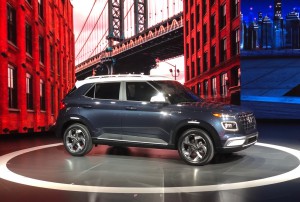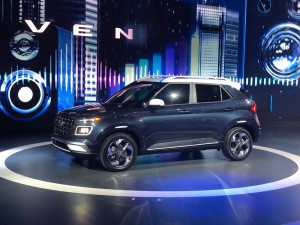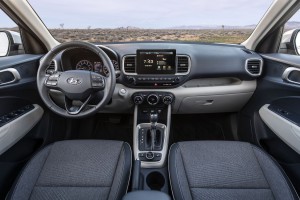
Hyundai keeps growing its sport-utility offerings. The new Venue, its smallest SUV, made its debut at the NYIAS.
Hyundai was one of the few automakers to use the Great Recession to its advantage, actually picking up sales and market share while the rest of the U.S. auto industry plunged to levels unseen in decades. Ironically, the Korean carmaker took an unexpected tumble as the rest of the market turned around, unprepared to adapt to the sudden shift from sedans and coupes to SUVs and CUVs.
Hyundai isn’t about to let that happen again, the automaker using this year’s New York International Auto Show to roll out the seventh, and newest, member of its rapidly expanding utility vehicle line-up, the 2020 Hyundai Venue. In sharp contrast to the recently added Palisade, its biggest and most lavish CUV, the subcompact Venue targets a mostly younger buyer on a tight budget.
“About one-third of (used car) buyers started out looking for a new vehicle but couldn’t afford it,” said Brian Smith, Hyundai Motor America’s chief operating officer, during the Venue’s NYIAS debut. “That’s a perfect opportunity for a vehicle like this.”
The 2020 Hyundai Venue measures just 158.0 inches, nose-to-tail, 5.1-inches shorts than the maker’s Kona, which had been its smallest utility vehicle, It’s a full 14 inches shorter than the Toyota C-HR, by comparison. The Venue is 69.7 inches wide, or 1.2 inches smaller than Kona and, at 99.2 inches, its wheelbase is 3.2 inches shorter. That said, its 61.6-inch height means it stands 0.6 inches taller than Kona.
(Hyundai names former Nissan exec José Muñoz its new COO. Click Here for the story.)
Among the limited but expanding group of comparable SUVs, Venue goes up against the likes of the new Nissan Kicks.
Those pint-sized dimensions could be particularly attractive to urban dwellers, whether in New York, San Francisco, London, Beijing or Seoul – or so the automaker is betting.
“The all-new Venue might be small in size, but it’s big on practicality and personality,” said Mike O’Brien, HMA’s vice president of Product, Corporate and Digital Planning. “It’s bold and unique character sets it apart from other SUVs on the market, offering a unique, entry-level vehicle for those consumers seeking savvy design with an abundance of standard safety, technology and connectivity features.”
The taller roofline helps Hyundai minimize Venue’s sense of claustrophobia. And, while it is expected to carry a price tag that can win over traditional used car buyers, the little crossover isn’t a bare bones stripper.
It offers a reasonable mix of features, even in its base configuration, including a number of advanced driver assistance systems. Whether standard or optional, ADAS technology includes forward collision avoidance assist, lane keeping assist, blind-spot warning, rear cross-traffic alert and driver attention warning.
(Click Here for details about the new Hyundai Sonata.)
The integration of both Apple CarPlay and Android Auto should appeal to budget-conscious millennials, as will its 8-inch touchscreen and Bluetooth. There’s even an available navigation system and niceties like access to Amazon’s Alexa voice assistant.
Power comes from a 121 horsepower 1.6-liter inline-four paired to either a six-speed manual or CVT gearbox, power directed to the front wheels, no all-wheel-drive package in the offing.
Oh, and if you’re wondering about the name, Hyundai says it refers to, “a place people want to be seen in.”
Whether that proves true for this four-wheeled Venue, well we’ll be seeing in the months ahead. Pricing is likely to be a key, Hyundai COO Smith acknowledged. And while he wouldn’t offer a specific figure he confirmed it will come in comfortably below Kona’s $19,240 base.
(Click Here to check out the Hyundai Kona Electric.)
Look for it in U.S. showrooms “by the end of the year,” he told us.


